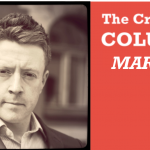Photo on your CV or not? – the complete guide
Should you include your photo on your CV or not? The young career planner or job seeker in a global setting will most probably get different answers to that question. In this guide Barry O’Brien, British career coach based in Stockholm, digs a little deeper into this disagreement.
This guide is a follow-up to Barry O’Brien’s Crastina Column of March 2016, The CV controversy: maybe you are asking the wrong question?
The CV controversy is very interesting as it puts the search light on four very important aspects of job seeking: geography, technology, online personal branding and making a good impression in real life.
Geography
You have to know that the job hunting game has different rules in different parts of the world.

Good old LinkedIn isn’t popular everywhere, so that amazing profile, including a great LinkedIn headshot photo you have, won’t mean as much in China or Germany, for instance. In Germany 99% of the time you must ALWAYS include a photo on your CV and they have professional photographers in most cities who supply a photographic service for this purpose. On the flip side you can see a different expectation in the USA, from a recent discussion on LinkedIn, started by someone in the US, over 1200 comments mainly said ‘NO’ to the question of including photos on resumes. One comment even said “No, I’m not signing up for a “Beauty Pageant” the skills and experience you bring to the table are more important.” It is an interesting viewpoint, but too narrow in its analysis and conclusion. Here’s why!
Here in Sweden, for example, I have many clients from all over the world, academics and business people from Iran, Iraq, China, India, Pakistan, Romania and many more countries, and they all know how ‘things are done’ in the job market in their own, or recently inhabited, country. However, many of them quickly realise that their native names are not so easy to recognize in western countries and decide that the solution is to include a photo on their CV, to clear up any uncertainty. My argument has always been that it shouldn’t matter whether you are male or female anyway as expertise, reputation and skills are the things that matter, but some clients have made the point that in Sweden many companies and institutions have gender targets, which can thus be more beneficial to an obviously female applicant as shown in her photo, because women are often under represented in certain sectors. Rightly or wrongly, this is another element of the job hunting ‘game’ and something to be aware of.
As I will continue to say throughout this article, understand how things work in your local job market, don’t make assumptions, ask the local experts and this will help you to know when to include a photo and when not to.
Technology
You have to know how the recruiters use digital tools.
 You may have heard of Applicant Tracking Systems. Maybe not? This is a brief guide to them.
You may have heard of Applicant Tracking Systems. Maybe not? This is a brief guide to them.
When you upload your CV to a company or recruiter ‘database’ it is entering the black hole world of an Applicant Tracking System (ATS). The development of the ATS market is a multi billion-dollar industry with many companies producing various systems of ranging quality. If a recruiter gets 200 CVs for a job advert, very often they will not read all of them but will receive a filtered number of select CVs that the ATS ‘robot’ has read and graded as a good match for the job role. One problem is that the ATS ‘robot’ cannot always read your CV, especially if it has a digital photo included in the file, which can result in corruption of your document. You will never know this of course, and never hear back from the recruiter and just make the assumption that you were not good enough!
You should always call a recruiter before sending in an application anyway, just to make contact, ask some genuine questions about the role and of course ask them about their ATS and if they know of any ‘weird’ things that it does. You can often shape a much better application after this discussion, refer to the telephone call in your email or letter, and create an expectation at their end, for the arrival of your CV.
Personal Branding
It’s not about your self-image – it’s about how other people perceive you.
 I have been working with marketing of products, off and on, for over 20 years. Marketing of people, isn’t so different and I was introduced to the concept of Personal Branding by a former recruiter in Sweden, Per Frykman (www.perfrykman.com). Per is now working with understanding and developing ‘Reputations’ for business people, and he was totally right when he explained to me that you can’t create a personal brand without knowing how other people perceive you, otherwise it isn’t genuine – it is just your own opinion! When it comes to any images that you use on your CV or LinkedIn, have you asked for a second opinion on whether they look professional? Do the images truly reflect you or should you use one that isn’t five years out of date?
I have been working with marketing of products, off and on, for over 20 years. Marketing of people, isn’t so different and I was introduced to the concept of Personal Branding by a former recruiter in Sweden, Per Frykman (www.perfrykman.com). Per is now working with understanding and developing ‘Reputations’ for business people, and he was totally right when he explained to me that you can’t create a personal brand without knowing how other people perceive you, otherwise it isn’t genuine – it is just your own opinion! When it comes to any images that you use on your CV or LinkedIn, have you asked for a second opinion on whether they look professional? Do the images truly reflect you or should you use one that isn’t five years out of date?
At the end of 2015 I became a Certified Social Branding Analyst, via the REACH organization in the USA, and during the training they went so far as to say that your photos should show you proudly looking towards the words that are describing you. So for instance on LinkedIn, your head should be slightly looking to the left at the written profile content that presents your unique selling points.
Perhaps that is a little extreme, but the quality of your images, the background, your clothing and jewelry and your facial expressions are all details to be aware of and seek second opinions on, before adding them to any CV.
A good impression
People hire people they ‘know, like and trust!’.
 Like it or not, we all like to work with, or hire, people we ‘know, like and trust!’ That is why, depending on where you read, most of the 75% of jobs that are not advertised, are filled via referrals from network contacts.
Like it or not, we all like to work with, or hire, people we ‘know, like and trust!’ That is why, depending on where you read, most of the 75% of jobs that are not advertised, are filled via referrals from network contacts.
What does your first impression look like online? How big is your industry network? Who do you know today that could arrange a lunch meeting for you, with a team manager in an industry company? These are all questions to consider and to start taking action on.
Growing your network is absolutely essential for long term career success, joining discussions and connecting with people on social media, booking mentor lunches via the LunchBack App (www.lunchback.co), attending relevant Meetup groups like ours (www.phdcareerlink.se) and of course by directly contacting decision makers in interesting companies with the ‘cold’ approach of emailing your single page CV, with a photo, in the form of a short bio, and asking to have an ‘info-meeting’ about their own career and role.
Ian Jenkins gives a clear guide on how to succeed with this process here although he suggests not to send your CV first, which I disagree with as there is no point hiding your intentions and the person you hope to meet will not be blind to your aims. They key is to send a 1 page ‘bio’ and not a 4-page CV!
The CV photo cheat sheet
So overall, I hope it is clear that in some cases it is OK to have a professional photo on your CV, but if not, here is the short guide I give my clients for the six CVs I use with their individual, optimised, job search strategies:
Database CV
This is never sent anywhere. Any length and should always be your first creation, noting every job, course and skill you have, which you can then use to build your other documents.
1-page Bio/Resume style
Include photo. Use this when emailing people in companies after perhaps connecting with them on LinkedIn or previously at a conference, or ‘coldly’ trying to get their attention to arrange a phone call and lunch meeting.
2-page CV
No photo. Direct response to a job advert when uploading to an ATS.
2-page CV
Include (optional) photo. Emailing directly to known Headhunters or Recruiters.
5-page CV
No photo. Upload this to job boards such as Monster and pack it with keywords so hopefully you are discovered by a recruiter searching for candidates.
An academic CV
No photo and as long as you like :0)
Barry O’Brien
Barry O’Brien is an English communications consultant and job search optimiser based in Stockholm, Sweden. He specialises in helping people who have English as a second language, to make a great first impression online or in real life. Among his clients are several universities, e.g. Karolinska Institutet, KTH and Luleå tekniska universitet.
- Websites: PhD Career Link; Your Career Link
- LinkedIn: se.linkedin.com/in/barryobriencomms
- Claire Price of Crastina receives outreach award from Royal Society of Biology - October 25, 2020
- Agile Science student project at Brussels Engineering School ECAM: “We can’t wait to try it again!” - August 28, 2020
- Create an infographic in the Lifeology SciArt Infographic Challenge - June 16, 2020
- Adam Ruben – The scientist that teaches undergraduate students comedy - March 27, 2020
- Sam Gregson, Bad Boy of Science: “Comedy helps to bridge the gap” - March 10, 2020
- The Coolest Science Merchandise of 2019 - December 16, 2019
- Science Media Centre (UK) offers guide on dealing with online harassment in academia - November 26, 2019
- Agile project management taught to students and researchers at Karolinska Institutet - September 20, 2019
- Stefan Jansson: Improve your credibility! (Crastina Column, September 2019) - September 6, 2019
- The People’s Poet: Silke Kramprich, tech communicator - August 31, 2019





Trackbacks & Pingbacks
[…] Those were just two examples to get you thinking, but feel free to read on here, with a more indepth guide. […]
Leave a Reply
Want to join the discussion?Feel free to contribute!